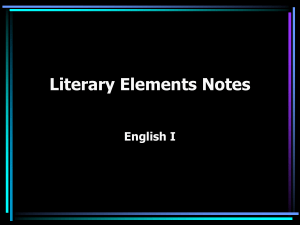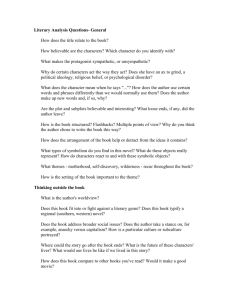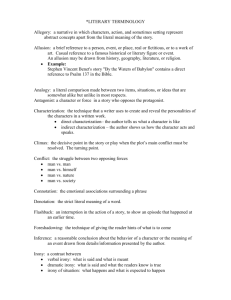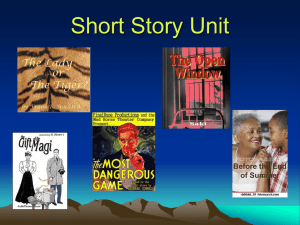literary devices
advertisement
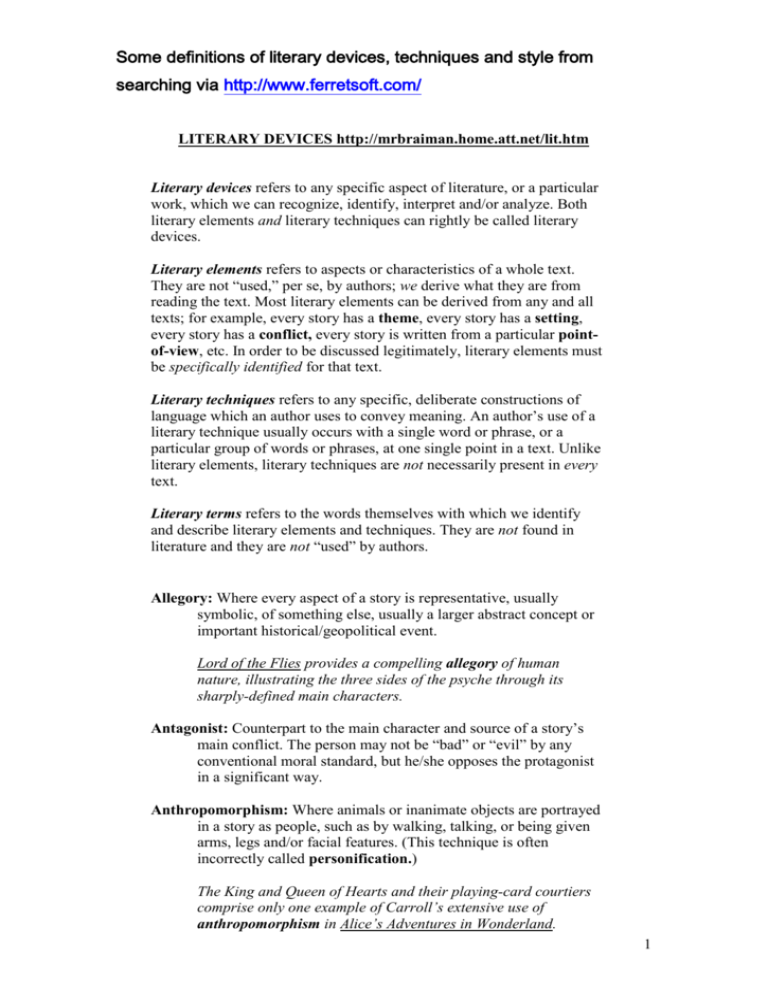
Some definitions of literary devices, techniques and style from searching via http://www.ferretsoft.com/ LITERARY DEVICES http://mrbraiman.home.att.net/lit.htm Literary devices refers to any specific aspect of literature, or a particular work, which we can recognize, identify, interpret and/or analyze. Both literary elements and literary techniques can rightly be called literary devices. Literary elements refers to aspects or characteristics of a whole text. They are not “used,” per se, by authors; we derive what they are from reading the text. Most literary elements can be derived from any and all texts; for example, every story has a theme, every story has a setting, every story has a conflict, every story is written from a particular pointof-view, etc. In order to be discussed legitimately, literary elements must be specifically identified for that text. Literary techniques refers to any specific, deliberate constructions of language which an author uses to convey meaning. An author’s use of a literary technique usually occurs with a single word or phrase, or a particular group of words or phrases, at one single point in a text. Unlike literary elements, literary techniques are not necessarily present in every text. Literary terms refers to the words themselves with which we identify and describe literary elements and techniques. They are not found in literature and they are not “used” by authors. Allegory: Where every aspect of a story is representative, usually symbolic, of something else, usually a larger abstract concept or important historical/geopolitical event. Lord of the Flies provides a compelling allegory of human nature, illustrating the three sides of the psyche through its sharply-defined main characters. Antagonist: Counterpart to the main character and source of a story’s main conflict. The person may not be “bad” or “evil” by any conventional moral standard, but he/she opposes the protagonist in a significant way. Anthropomorphism: Where animals or inanimate objects are portrayed in a story as people, such as by walking, talking, or being given arms, legs and/or facial features. (This technique is often incorrectly called personification.) The King and Queen of Hearts and their playing-card courtiers comprise only one example of Carroll’s extensive use of anthropomorphism in Alice’s Adventures in Wonderland. 1 Blank verse: Non-rhyming poetry, usually written in iambic pentameter. Most of Shakespeare’s dialogue is written in blank verse, though it does occasionally rhyme. Characterization: The author’s means of conveying to the reader a character’s personality, life history, values, physical attributes, etc. Also refers directly to a description thereof. Atticus is characterized as an almost impossibly virtuous man, always doing what is right and imparting impeccable moral values to his children. Climax: The turning point in a story, at which the end result becomes inevitable, usually where something suddenly goes terribly wrong; the “dramatic high point” of a story. The story reaches its climax in Act III, when Mercutio and Tybalt are killed and Romeo is banished from Verona. Conflict: A struggle between opposing forces which is the driving force of a story. The outcome of any story provides a resolution of the conflict(s); this is what keeps the reader reading. Conflicts can exist between individual characters, between groups of characters, between a character and society, etc., and can also be purely abstract (conflicting ideas). The conflict between the Montagues and Capulets causes Romeo and Juliet to behave irrationally once they fall in love. Jack’s priorities are in conflict with those of Ralph and Piggy, which causes him to break away from the group. Man-versus-nature is an important conflict in The Old Man and the Sea. Context: Facts and conditions surrounding a given situation. Madame Defarge’s actions seem almost reasonable in the context of the Revolution. Creative license: Exaggeration or alteration of objective facts or reality, for the purpose of enhancing meaning in a fictional context. Orwell took some creative license with the historical events of the Russian Revolution, in order to clarify the ideological conflicts. Dialogue: Where characters speak to one another; may often be used to substitute for exposition. Since there is so little stage direction in Shakespeare, many of the characters’ thoughts and actions are revealed through dialogue. 2 Dramatic irony: Where the audience or reader is aware of something important, of which the characters in the story are not aware. Macbeth responds with disbelief when the weird sisters call him Thane of Cawdor; ironically, unbeknownst to him, he had been granted that title by king Duncan in the previous scene. Exposition: Where an author interrupts a story in order to explain something, usually to provide important background information. The first chapter consists mostly of exposition, running down the family’s history and describing their living conditions. Figurative language: Any use of language where the intended meaning differs from the actual literal meaning of the words themselves. There are many techniques which can rightly be called figurative language, including metaphor, simile, hyperbole, personification, onomatopoeia, verbal irony, and oxymoron. (Related: figure of speech) The poet makes extensive use of figurative language, presenting the speaker’s feelings as colors, sounds and flavors. Foil: A character who is meant to represent characteristics, values, ideas, etc. which are directly and diametrically opposed to those of another character, usually the protagonist. The noble, virtuous father Macduff provides an ideal foil for the villainous, childless Macbeth. Foreshadowing: Where future events in a story, or perhaps the outcome, are suggested by the author before they happen. Foreshadowing can take many forms and be accomplished in many ways, with varying degrees of subtlety. However, if the outcome is deliberately and explicitly revealed early in a story (such as by the use of a narrator or flashback structure), such information does not constitute foreshadowing. Willy’s concern for his car foreshadows his eventual means of suicide. Hyperbole: A description which exaggerates. The author uses hyperbole to describe Mr. Smith, calling him “the greatest human being ever to walk the earth.” Iambic pentameter: Poetry written with each line containing ten syllables, in five repetitions of a two-syllable pattern wherein the pronunciation emphasis is on the second syllable. Shakespeare wrote most of his dialogue in iambic pentameter, often having to adjust the order and nature of words to fit the syllable pattern, thus endowing the language with even greater meaning. 3 Imagery: Language which describes something in detail, using words to substitute for and create sensory stimulation, including visual imagery and sound imagery. Also refers to specific and recurring types of images, such as food imagery and nature imagery. The author’s use of visual imagery is impressive; the reader is able to see the island in all its lush, colorful splendor by reading Golding’s detailed descriptions. Irony (a.k.a. Situational irony): Where an event occurs which is unexpected, and which is in absurd or mocking opposition to what is expected or appropriate. (Note: Most of the situations in the Alanis Morissette song are not ironic at all.) See also Dramatic irony; Verbal irony. Jem and Scout are saved by Boo Radley, who had ironically been an object of fear and suspicion to them at the beginning of the novel. Metaphor: A direct relationship where one thing or idea substitutes for another. Shakespeare often uses light as a metaphor for Juliet; Romeo refers to her as the sun, as “a rich jewel in an Ethiop’s ear,” and as a solitary dove among crows. Mood: The atmosphere or emotional condition created by the piece, within the setting. The mood of Macbeth is dark, murky and mysterious, creating a sense of fear and uncertainty. Motif: A recurring important idea or image. A motif differs from a theme in that it can be expressed as a single word or fragmentary phrase, while a theme usually must be expressed as a complete sentence. Blood is an important motif in A Tale of Two Cities, appearing numerous times throughout the novel. Onomatopoeia: Where sounds are spelled out as words; or, when words describing sounds actually sound like the sounds they describe. Remarque uses onomatopoeia to suggest the dying soldier’s agony, his last gasp described as a “gurgling rattle.” Oxymoron: A contradiction in terms. Romeo describes love using several oxymorons, such as “cold fire,” “feather of lead” and “sick health,” to suggest its contradictory nature. 4 Paradox: Where a situation is created which cannot possibly exist, because different elements of it cancel each other out. In 1984, “doublethink” refers to the paradox where history is changed, and then claimed to have never been changed. A Tale of Two Cities opens with the famous paradox, “It was the best of times, it was the worst of times.” Parallelism: Use of similar or identical language, structures, events or ideas in different parts of a text. Hobbs’ final strikeout parallels the Whammer’s striking out against him at the beginning of the novel. Personification (I) Where inanimate objects or abstract concepts are seemingly endowed with human self-awareness; where human thoughts, actions and perceptions are directly attributed to inanimate objects or abstract ideas. (Not to be confused with anthropomorphism.) Malamud personifies Hobbs’ bat, giving it a name, Wonderboy, referring to it using personal pronouns, and stating that “he went hungry” during Hobbs’ batting slump. Personification (II) Where an abstract concept, such as a particular human behavior or a force of nature, is represented as a person. The Greeks personified natural forces as gods; for example, the god Poseidon was the personification of the sea and its power over man. Plot: Sequence of events in a story. Most literary essay tasks will instruct the writer to “avoid plot summary;” the term is therefore rarely useful for response or critical analysis. When discussing plot, it is generally more useful to consider its structure, rather than simply “what happens.” Point-of-view: The identity of the narrative voice; the person or entity through whom the reader experiences the story. May be thirdperson (no narrator; omniscient or limited) or first-person (narrated by a character in the story). Point-of-view is a commonly misused term; it does not refer to the author’s (or characters’) feelings, opinions, perspectives, biases, etc. Though it is written in third-person, Animal Farm is told from the point-of-view of the common animals, unaware of what is really happening as the pigs gradually and secretively take over the farm. Writing the story in first-person point-of-view enables the reader to experience the soldier’s fear and uncertainty, limiting the narrative to what only he saw, thought and felt during the battle. 5 Protagonist: The main character in a story, the one with whom the reader is meant to identify. The person is not necessarily “good” by any conventional moral standard, but he/she is the person in whose plight the reader is most invested. Repetition: Where a specific word, phrase, or structure is repeated several times, to emphasize a particular idea. The repetition of the words “What if…” at the beginning of each line reinforces the speaker’s confusion and fear. Setting: The time and place where a story occurs. The setting can be specific (e.g., New York City in 1930) or ambiguous (e.g., a large urban city during economic hard times). Also refers directly to a description thereof. The novel is set in the South during the racially turbulent 1930’s, when blacks were treated unfairly by the courts. With the island, Golding creates a pristine, isolated and uncorrupted setting, in order to show that the boys’ actions result from their own essential nature rather than their environment. Simile: An indirect relationship where one thing or idea is expressed as being similar to another. Similes usually contain the words “like” or “as,” but not always. The simile in line 10 describes the lunar eclipse: “The moon appeared as a large drop of blood.” Speaker: The “voice” of a poem; not to be confused with the poet him/herself. Analogous to the narrator in prose fiction. Structure: The manner in which the various elements of a story are assembled. The individual tales are told within the structure of the larger framing story, where the 29 travelers gather at the Inn at Southwark on their journey to Canterbury, telling stories to pass the time. The play follows the traditional Shakespearean five-act plot structure, with exposition in Act I, development in Act II, the climax or turning point in Act III, falling action in Act IV, and resolution in Act V. Symbolism: The use of specific objects or images to represent abstract ideas. This term is commonly misused, describing any and all representational relationships, which in fact are more often metaphorical than symbolic. A symbol must be something tangible or visible, while the idea it symbolizes must be something abstract or universal. 6 Golding uses symbols to represent the various aspects of human nature and civilization as they are revealed in the novel. The conch symbolizes order and authority, while its gradual deterioration and ultimate destruction metaphorically represent the boys’ collective downfall. Theme: The main idea or message conveyed by the piece. A theme is generally stated as a complete sentence; an idea expressed as a single word or fragmentary phrase is a motif. Orwell’s theme is that absolute power corrupts absolutely. The idea that human beings are essentially brutal, savage creatures provides the central theme of the novel. Tone: The apparent emotional state, or “attitude,” of the speaker/narrator/narrative voice, as conveyed through the language of the piece. The poem has a bitter and sardonic tone, revealing the speaker’s anger and resentment. The tone of Gulliver’s narration is unusually matter-of-fact, as he seems to regard these bizarre and absurd occurrences as ordinary or commonplace. Tragedy: Where a story ends with a negative or unfortunate outcome which was essentially avoidable, usually caused by a flaw in the central character’s personality. Tragedy is really more of a dramatic genre than a literary element; a play can be referred to as a tragedy, but tragic events in a story are essentially part of the plot, rather than a literary device in themselves. Tragic hero/tragic figure: A protagonist who comes to a bad end as a result of his own behavior, usually cased by a specific personality disorder or character flaw. Willy Loman is one of the best-known tragic figures in American literature, oblivious to and unable to face the reality of his life. Tragic flaw: The single characteristic (usually negative) or personality disorder which causes the downfall of the protagonist. Othello’s tragic flaw is his jealousy, which consumes him so thoroughly that he is driven to murder his wife rather than accept, let alone confirm, her infidelity. Verbal irony: Where the meaning is intended to be the exact opposite of what the words actually mean. (Sarcasm is a tone of voice that often accompanies verbal irony, but they are not the same thing.) Orwell gives this torture and brainwashing facility the ironic title, “Ministry of Love.” 7 LITERARY TECHNIQUES AND DEVICES http://jacinet.johnabbott.qc.ca/webpages/departments/english/lallier/techniques.htm PLOT STRUCTURE 1. EXPOSITION (SETTING THE SCENE, BACKGROUND INFORMATION ABOUT CHARACTERS, ESTABLISHMENT OF A CONFLICT) 2. RISING ACTION (DEVELOPMENT AND INTENSIFICATION OF CONFLICT, GROWING SENSE OF TENSION) 3. CLIMAX (HIGH POINT OF TENSION AND CONFLICT) MARKS A MAJOR TURNING POINT FOR ONE OR MORE OF THE CHARACTERS 4. DENOUEMENT (OUTCOME OR RESOLUTION OF CONFLICT) MAY BE LEFT TO THE READER TO DECIDE BASED ON THE EVIDENCE IN THE STORY CAUSALITY A plot is not an random string of events. It has a logic based on cause and effect relationships between things that happen in the story. Ask yourself why certain things happen, why characters do, say and feel what they do. Then ask yourself what effects these causes have on the characters and conflict. Be aware that complex human behaviour in fiction may have more than one cause, or perhaps both immediate and more hidden, but more important causes. Example: In "Shakespeare's Sister," Virginia Woolf shows the multiple causes of Judith's failure to fulfill her creative potential as a writer, e.g., lack of education, domestic duties, the obligation to marry, gender stereotypes about women not being suited for the stage, unwanted pregnancy and nowhere to turn. All these immediate causes point to a more underlying cause of Judith's 8 failure: gender inequality in the Elizabethan age. FORESHADOWING Foreshadowing is a plot-related literary technique whereby an author shows or says something in an early part of a story that hints at a later event. Psychologically, foreshadowing prepares us for what is to come in the story, particularly the ending. When we finally reach the ending, and if we have read carefully, we may experience a sense of inevitability because we have consciously or subconsciously responded to foreshadowing earlier in the story. Example: 1. In The Awakening, the scene where Edna finally learns how to swim foreshadows the ending where she commits suicide by swimming to her death. When we close read the swimming scene, we see that Edna wanted to swim far out, "where no woman had swum before." The danger of this journey is foreshadowed by Edna's moment of terror at thought of not being able to regain the shore (a metaphor of social conventions and gender norms in Chopin's time). At the end of the novel, Edna recalls this scene, and this time continues swimming out, unafraid now, even though her strength will fail her. FLASHBACK A flashback is an interruption in the chronological sequence of events in the plot. It narrates a scene that occurred earlier. It may be a way of working questions of memory into a plot, imitating the way the human mind works, showing the relationship between past and present, or showing how an earlier event caused a later event. You are probably familiar with the technique of flashback in movies. The ending of Pulp Fiction, for example, is a flashback to an earlier scene in the film, where we saw Samuel Jackson and John Travolta in the same restaurant they are sitting in at the end.. IRONY A LITERARY DEVICE OR TECHNIQUE; AN INDIRECT WAY OF STATING AN IDEA FOR PERSUASIVE OR ARTISTIC EFFECT A WINK TO THE READER A COMPLIMENT TO THE INTELLIGENCE OR KNOWLEDGE OF READERS 9 THREE TYPES OF IRONY: 1. VERBAL IRONY: SAYING ONE THING AND MEANING ANOTHER CAN BE USED TO RIDICULE, BUT USUALLY MORE SOPHISTICATED THAN SIMPLE SARCASM Example: The opening line of Jane Austen's Pride and Prejudice is famous for its clever irony: "It is a truth universally acknowledged, that a single man in possession of a good fortune, must be in want of a wife." What Austen really means is women would be in want of a husband who has a good fortune. 2. SITUATIONAL OR STRUCTURAL IRONY: A CONTRAST BETWEEN WHAT WE EXPECT AND WHAT ACTUALLY HAPPENS, OFTEN FOR THE WORSE AN AWARENESS OF THE DIFFERENCE BETWEEN APPEARANCE AND REALITY, THE IDEAL AND THE ACTUAL, FALSE OR NAIVE HOPES VS. REAL OUTCOMES Example: A major irony in "The Yellow Wallpaper" is that the rest cure does not cure Jane, but actually ends up driving her mad. 3. DRAMATIC IRONY: THE NARRATOR OF A TEXT AND THE READER KNOW SOMETHING THAT A CHARACTER DOESN'T KNOW OTHER CHARACTERS IN THE TEXT KNOW SOMETHING THAT A CHARACTER DOESN'T KNOW A CHARACTER SAYS SOMETHING THAT SHOWS HOW LITTLE HE/SHE KNOWS THE TRUTH ABOUT THEMSELVES STORIES IN FIRST-PERSON NARRATION ARE OFTEN IRONIC BECAUSE THE NARRATOR/CHARACTER HAS LIMITED KNOWLEDGE OF SELF, OTHERS OR LIFE AND DOESN'T KNOW IT Example: In "The Yellow Wallpaper," Jane makes comments about how "unreasonably angry" she gets at John sometimes. A look at John's condescending 10 behaviour to his wife makes it clear to the reader that Jane probably has good reason to get angry, but feels too guilty about not performing her role as a "rest and a comfort" to John to accept her feelings. Both the author and the reader have greater insight into Jane's situation than she does herself. METAPHOR A metaphor is a kind of figurative language in which one concrete thing, event or action (called the "vehicle") is compared to or stands for something literally quite different and often more abstract (called the "tenor"). The vehicle is always stated in a metaphor, but the tenor (what the vehicle is like or stands for) may only be implied. A metaphor is like a SIMILE, but simile uses "like" or "as" to make the comparison explicit. Examples: 1. The "Angel in the House" is a metaphor for the type of woman considered ideal in Woolf's time, what we could call the Victorian ideology of femininity. It is also an extended metaphor, since Woolf's struggle with the Angel is developed at considerable length and in concrete metaphoric language ("I flung the inkpot at her"). Metaphors can also be very short, e.g., Hamlet compares his problems to a "sea of troubles." 2. The yellow wallpaper is a metaphor for Jane's oppressive situation in her marriage and her inner desire to break free of restrictive gender norms. (Notice that "break free" is a metaphor too since Jane is not literally imprisoned. 3. "How sweet the moonlight sleeps upon this bank" (William Shakespeare). The vehicle "sleeps" suggests that the moonlight upon the riverbank looks quiet and peaceful (tenor). 4. Sojourner Truth uses the metaphor of small and big cups, both of which should be filled, to stand for her idea that human rights should not depend on a person's intellect. 5. Virginia Woolf uses the metaphor of having a "room of one's own" to represent economic independence, time, privacy, freedom of thought--all the things that are necessary in order to do creative work. 11 Literary technique From Wikipedia, the free encyclopedia. http://en.wikipedia.org/wiki/Literary_technique Novels and short stories do not simply come from nowhere. Usually the author employs some general literary technique (also called a literary device) as a framework for artistic work. [edit] Annotated list of literary techniques Author surrogate, a character who acts as the author's spokesman. Autobiographical novel, tales of the author's life as seen by the author in fictional form; sometimes significant changes are made. An example is James Joyce's A Portrait of the Artist as a Young Man. Back-story provides extra depth to the story by anchoring it to external events, real or imagined. Breaking the fourth wall is acknowledging to the reader or audience that what is being presented is fiction. Constrained writing, in which artificial constraints, such as "no words containing the letter 'e'", are imposed. Epistolary novel, novel in the form of letters exchanged between the characters. Examples include Samuel Richardson's Pamela, Tobias Smollett's Humphry Clinker, Bram Stoker's Dracula. False documents, fiction written in the form of, or about, apparently real, but actually fake documents. Examples include Robert Graves' I, Claudius, a fictional autobiography of the Roman emperor Claudius; and H. P. Lovecraft's Necronomicon, a fictional book of evil that appeared frequently in horror fiction and film, written by both Lovecraft and his admirers. First-person narrative, the narrator tells his own tale Flashback, general term for altering time sequences, taking characters back to the beginning of the tale, for instance. Foreshadowing, hinting at events to occur later. Frame tale, or a story within a story, where a main story is used to organise a series of shorter stories. Historical novel, story set amidst historical events, pioneered by Sir Walter Scott in his novels of Scottish history. Protagonists may be fictional or historical personages, or a combination. Hysterical realism, is a literary genre characterized by chronic length, manic characters, madding action, and frequent digressions on topics secondary to the story. Magic realism, a form particularly popular in Latin American but not limited to that region, in which events are described realistically, but in a magical haze of strange local customs and beliefs. Gabriel García Márquez is a notable author in the style. Narrative, fiction written as if it were related to the reader by a single participant or observer. 12 Omniscient narrator, particular form of narrative in which the narrator sees and knows all Overstatement, exaggeration of something, often for the purpose of emphasis Parody, ridicule by imitation, usually humorous, such as MAD Magazine Pastiche, using forms and styles of another author, generally as an affectionate tribute, such as the many stories featuring Sherlock Holmes not written by Arthur Conan Doyle, or much of the Cthulhu Mythos. Picaresque novel, episodic recounting of the adventures of a rogue (Spanish picaro) on the road, such as Tom Jones or Huckleberry Finn. Plot twist Roman a clef, a "novel with a key", that is, whose characters and plot are related to real-life happenings Satire, "An attack on wickedness and folly", as Samuel Johnson called it, such as A Modest Proposal or Candide. Satires are not necessarily humorous; for example, dystopian novels such as 1984 and Brave New World have satiric elements. Shared universe is a shared back-story. Story within a story Stream of consciousness, an attempt to portray all the thoughts and feelings of a character, as in parts of James Joyce and Virginia Woolf. Word play, in which the nature of the words used themselves become part of the work Authors also manipulate the language of their works to create a desired response from the reader. This is the realm of the rhetorical devices. Retrieved from "http://en.wikipedia.org/wiki/Literary_technique" 13 Checklist: Elements of Literary Style http://www.lakesideschool.org/upperschool/departments/english/ErikChristensen/WRITING %20STRATEGIES/LiteraryStyles.htm 1. Sentence Structure 2. Pace 3. Expansive/Economical Diction 4. Vocabulary 5. Figures of speech 6. Use of Dialogue 7. Point of View 8. Character development 9. Tone 10. Word Color, Word Sound 11. Paragraph / Chapter Structure 12. Time Sequencing / Chronology 13. Allusions 14. Experimentation in Language 15. Metafictional techniques Are the sentences long or short? Do they contain many subordinate clauses, or are they often fragments? Are there any digressions or interruptions? Is the word-order straightforward or unconventionally crafted? Is the writing heavily descriptive, with emphasis on setting and atmosphere, or does it focus on action and plot movement? Is the writing tight and efficient, or elaborate and long-winded? When does the author use one or the other and why? Are the words simple or fancy? Are they technical, flowery, colloquial, cerebral, punning, obscure? (And so on...) Are there any metaphors, similes, or symbols? Any other use of figurative language (personification, metonymy, etc.)? How often does dialogue tell the story? Do we see whole conversations or just fragments? Does the conversation use much slang or is it formal? Does it appear natural or contrived? Does the dialogue give a sense of pacing, of pauses, of the unsaid? How much does it substitute for narration? First, second, third, omniscient, limited omniscient, multiple, inanimate? How does the author introduce characters, and how do we see their evolution in the story? What is their function and motivation? What kinds of characters are they? Full/round? Stock characters? Stereotypes? Caricatures? What is the author’s attitude? What is the mood of the story? Does the author seem sarcastic? aggressive? wistful? pessimistic? in love? philosophically detached? hopeful? ironic? bitter? (And so on...) Whatever the tone, where is it visible in the narrative? How much does the language call attention to or depend on the quality of its sound, e.g. through alliteration, assonance, consonance, dissonance, rhythm, unusual word choice, etc.? Are paragraphs very short, or are they enormous blocks running across many pages? Are the chapters short or long? How many are there, how are they organized, and why is this important? How has the author organized the chronology of events? To what effect? What is the work’s structural “rhythm”? How often and how does the author refer to other texts, myths, symbols, famous figures, historical events, quotations, and so on? Are there any unusual techniques, such as stream-ofconsciousness, mixing styles and genres, unusual layout on the page, breaking rules of grammar and form, odd or unstable narrative perspectives, onomatopoeia, aporia, etc.? Does the author call attention to his or her own process of narration? Are the narrator’s position, role, and thoughts as a storyteller mentioned explicitly in the text? What function do they serve? 14

